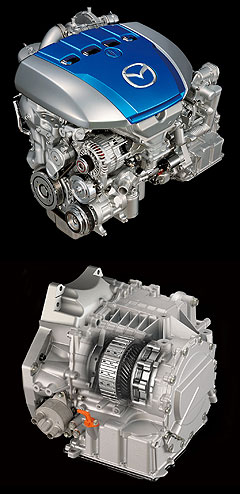Next Mazda6 might return 4.0L/100km
BY MARTON PETTENDY | 17th Mar 2010

Due to emerge globally in 2012, the redesigned Mazda6 will combine turbo-diesel power with an automatic transmission for the first time, when it debuts the Japanese’s brand’s next-generation Sky-D clean-diesel engine with its new Sky-Drive six-speed automatic transmission.
Mazda has promised to reduce the weight of its next-generation models by an average of 100kg, as part of its commitment to reduce its corporate average fuel consumption by 30 per cent between 2008 and 2015.
Revealed at the Tokyo motor show last October, the Sky-D engine is claimed to reduce fuel consumption by 20 per cent over the current engine, which delivers 132kW and 400Nm of torque in the 2010 Mazda6.
The current manual-only Six diesel returns 5.9L/100km in the hatch and 6.0L/100km in the wagon.

However, the Sky-D engine, which incorporates two-stage turbochargers, a low-friction engine block and piezo-electric injectors, will be combined with a regenerative braking and the same ‘i-stop’ idle-stop system that emerged on the Mazda Kiyora concept at the 2008 Paris motor show.
That concept was powered by an new super-low-emissions 1.3-litre four-cylinder petrol engine that returned average fuel consumption of just 3.1L/100km and CO2 emissions of less than 90g/km, bettering the Prius.
Said to deliver 15 per cent better fuel consumption than Mazda’s current 2.0-litre petrol engine, the 1.3 DI turbo four is also claimed to match the efficiency of the outgoing 2.2-litre turbo-diesel that powers the current Mazda3 and Mazda6.
It represents the first of Mazda’s new-generation Sky-G petrol engines that could debut in the next-generation Mazda2 in 2011, before going on sale here in 2012.
While the replacement for the 2.2 MZR-CD is said to be 20 per cent more efficient, Mazda claims its idle-stop system can reduce fuel use by up to 15 per cent, while the new six-speed auto is claimed to be responsible for a five per cent economy increase.
Autocar reports Mazda sources as saying the next Mazda6 could return CO2 emissions as low as 105g/km – down from a current 154g/km.
While that’s more than the 89g/km CO2 output of the Prius hybrid, which Toyota points out produces fewer harmful gases including NOx, it is significantly less than the Camry Hybrid (142g/km).
Based on the current Mazda6 hatch’s average of 5.9L/100km, a similar reduction in fuel economy could see the next-gen Six average drop to as little as 4.0L/100km.
Currently, the most fuel-efficient car on the Australian market is Ford’s pint-sized, diesel-powered Fiesta Econetic manual, at 3.7L/100km.
Fitted with all of Mazda's forthcoming powertrain technologies, the replacement for the similarly sized Mazda2 - and perhaps even the next Mazda3 - should be even more economical.
When it appeared, the Kiyora concept was seen as a sneak-preview of an all-new sub-B segment model that would potentially morph into the 'Mazda1' to rival Toyota's iQ and slightly larger Aygo.
However, Japan's third-largest car-maker appears to have gone cold on a model that would sit between the Two and its Japan-only 'Kei car', the long-running Suzuki Swift-based Mazda Carol.
Although Mazda is reportedly set to share hybrid technology with Toyota by the middle of this decade, its exclusive reliance on conventional engine technology in the medium-term is in stark contrast with other manufacturers’ headlong march to new technology.
Mazda Australia marketing manager Alastair Doak said: “All our next-generation models will be more economical, as we have said.
“What we are going to do is use aerodynamics, weight reduction and Sky and other powertrain technologies and develop them within an inch of their lives.
“We will take technology that is affordable and apply it across our entire model range rather than on just one model.
“It is just a progression of what happens now, but it will be highly accelerated.
“Whether that is sexy as hybrid, only the customer can decide.
“We will eventually have hybrids, but ultimately we will always have cars that are fun to drive rather than boring.”